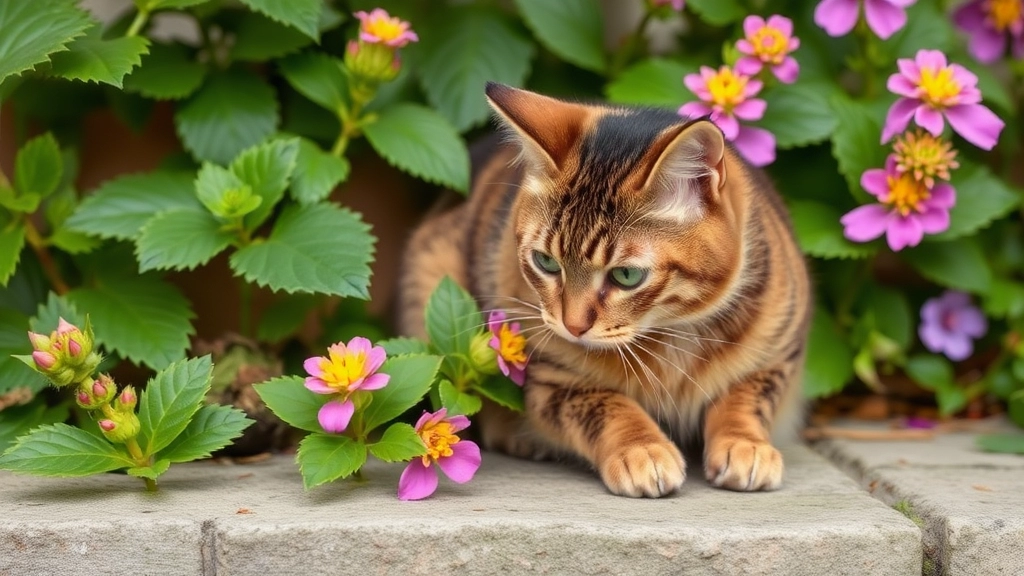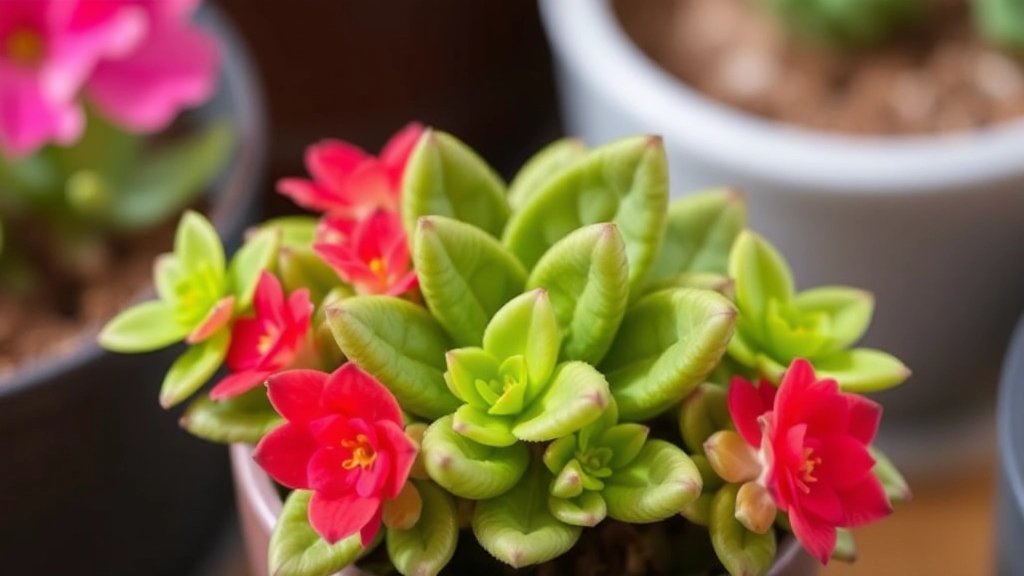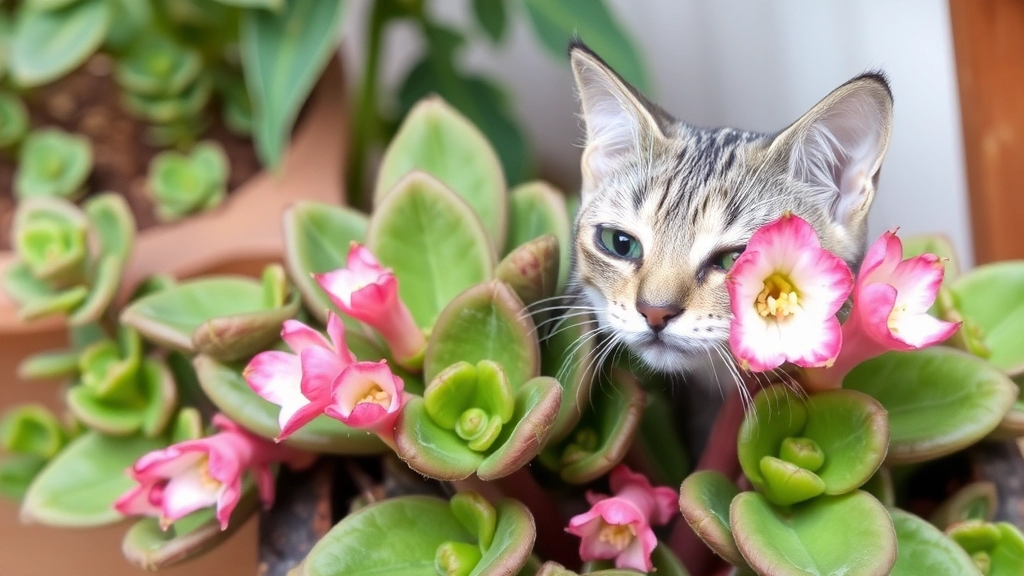Is Kalanchoe Toxic to Cats?
If you’re a cat owner, you might be wondering, “Is Kalanchoe toxic to cats?” The short answer is yes. This popular houseplant, while beautiful, poses a serious risk to our feline friends. As a responsible pet parent, it’s crucial to understand the dangers and take steps to keep your curious kitty safe.
Understanding the Risks
In this article, we’ll dive into why Kalanchoe is harmful to cats, the symptoms of poisoning, and what to do if your cat ingests any part of this plant. By staying informed, you can ensure your home is both stylish and safe for your beloved pets.
Symptoms of Kalanchoe Poisoning in Cats
As a cat owner, it’s natural to worry about the safety of your feline friend, especially when it comes to houseplants. Kalanchoe, while beautiful, can pose serious risks to your cat’s health if ingested.
Key Symptoms to Watch For:
- Vomiting: One of the most common signs, often occurring shortly after ingestion.
- Diarrhoea: Loose stools may accompany vomiting, indicating gastrointestinal distress.
- Lethargy: Your cat may seem unusually tired or less active than normal.
- Loss of Appetite: If your cat suddenly refuses food, it could be a sign of poisoning.
- Abdominal Pain: Signs of discomfort may be evident, such as hiding or a tense abdomen.
- Cardiac Issues: In severe cases, Kalanchoe poisoning can lead to arrhythmias or other heart problems.
Recognising these symptoms early is crucial for your cat’s well-being. For more detailed information on the toxicity and safety of Kalanchoe, you can refer to our guide on Kalanchoe plant toxicity. Additionally, if you are interested in understanding the potential risks and benefits of these plants, our article on the safety of eating Kalanchoe provides comprehensive insights.
Immediate Actions to Take if Your Cat Ingests Kalanchoe

So, you’ve just discovered that your cat has nibbled on some Kalanchoe. Panic sets in, right? Don’t worry; I’ve got your back. Here’s what you need to do right away.
Stay Calm and Assess the Situation
First things first, take a deep breath. Your cat is likely feeling just as confused as you are. Look for symptoms like:
- Vomiting
- Diarrhoea
- Lethargy
- Changes in appetite
- Abdominal pain
If you notice any of these, it’s time to act fast.
Contact Your Vet
Your next step should be to call your vet. Don’t wait around.
- Provide Details: Share information about how much Kalanchoe your cat may have eaten and any symptoms you’ve noticed.
- Follow Their Advice: Your vet may ask you to bring your cat in for an examination or give you specific instructions to follow at home.
Inducing Vomiting? Not So Fast!
You might think about making your cat vomit, but hold up! Only do this if your vet tells you to. Inducing vomiting without guidance can sometimes make things worse.
Keep Your Cat Comfortable
While waiting for professional help, keep your cat calm and comfortable.
- Create a Quiet Space: A cozy spot away from noise can help ease their anxiety.
- Monitor Their Condition: Keep an eye on any changes in behaviour or symptoms.
Prepare for the Vet Visit
If you have to go to the vet, it’s helpful to gather some information:
- Plant Details: Bring a piece of the Kalanchoe or a photo to help identify it.
- Health History: Know your cat’s medical history, including any medications they’re on.
When a cat ingests Kalanchoe, the immediate symptoms can be alarming, but what about the long-term health effects? This is a crucial concern for pet owners who may be worried about their furry companions.
Kalanchoe contains compounds called bufadienolides, which can lead to significant health issues if ingested. Here are some potential long-term effects to consider:
– **Cardiac Issues:** Prolonged exposure can lead to heart problems, including arrhythmias. This can manifest as lethargy or difficulty breathing.
– **Gastrointestinal Disturbances:** Cats may experience ongoing digestive issues, such as vomiting or diarrhea, which can lead to dehydration and further complications.
– **Kidney Damage:** In severe cases, kidney function can be impaired, resulting in chronic kidney disease. This requires careful monitoring and management.
– **Neurological Effects:** Some cats may exhibit changes in behaviour or coordination, indicating potential neurological damage.
It’s important to note that the severity of these effects can vary based on the amount ingested and the individual cat’s health.
If you suspect your cat has ingested Kalanchoe, timely veterinary intervention can mitigate some of these long-term risks. For more information on the potential dangers and benefits of Kalanchoe, you might find it helpful to read about whether it is safe to eat Kalanchoe and the associated risks. Additionally, understanding the different types of Kalanchoe plants can help you identify which species might be more harmful to pets.
Alternative Pet-Safe Plants to Kalanchoe

If you’re concerned about the risks of Kalanchoe poisoning, you’re not alone. Many cat owners seek safe alternatives to ensure their furry friends can explore their environment without danger.
Here are some pet-safe plants that can brighten your home without the worry:
1. Spider Plant (Chlorophytum comosum)
- Benefits: Easy to care for and known for its air-purifying qualities.
- Cat Appeal: Cats often enjoy playing with its long, arching leaves.
2. Boston Fern (Nephrolepis exaltata)
- Benefits: Adds a lush, green touch to any room and helps maintain humidity.
- Cat Appeal: The feathery fronds are perfect for curious paws.
3. Areca Palm (Dypsis lutescens)
- Benefits: A beautiful indoor palm that thrives in indirect light.
- Cat Appeal: Its feathery leaves are irresistible for cats to bat at.
4. Bamboo Palm (Chamaedorea seifrizii)
- Benefits: Great for improving indoor air quality and low maintenance.
- Cat Appeal: The slender stems can be a fun challenge for your cat.
5. Parlor Palm (Chamaedorea elegans)
- Benefits: A hardy plant that can tolerate low light, making it perfect for indoor spaces.
- Cat Appeal: Its gentle sway can intrigue even the most indifferent feline.
6. Christmas Cactus (Schlumbergera)
- Benefits: A unique flowering plant that blooms beautifully during winter.
- Cat Appeal: Its interesting shape can pique your cat’s curiosity.
7. Calathea
- Benefits: Known for its stunning leaf patterns and colours, adding vibrancy to your home.
- Cat Appeal: The movement of the leaves can attract your cat’s attention.
By choosing pet-safe plants, you can create a beautiful and safe environment for both you and your cat.
Preventing Plant Poisoning in Cats
As a cat owner, it’s natural to worry about what your furry friend might chew on, especially when it comes to toxic plants like Kalanchoe.
Understanding the Risks
Have you ever wondered how to keep your cat safe from harmful plants?
Here are some straightforward strategies to prevent plant poisoning in cats:
- Research Before You Buy: Always check if a plant is safe for cats before bringing it home. Use reliable resources or apps that list toxic and non-toxic plants. For example, learn about Florist Kalanchoe Toxicity to ensure you make informed decisions.
- Create a Cat-Free Zone: Designate areas in your home where plants are off-limits. Consider using barriers or shelves that are out of your cat’s reach.
- Opt for Pet-Safe Alternatives: Choose plants that are known to be safe for cats. Some popular options include spider plants, Boston ferns, and cat grass.
- Educate Yourself and Others: Share information about toxic plants with family and friends. This ensures everyone in your home is aware and can help keep your cat safe.
- Regularly Inspect Your Plants: Check for any signs of nibbling or interest from your cat. If you notice your cat showing curiosity, it might be time to relocate the plant.
- Provide Distractions: Offer your cat engaging toys or cat-safe plants to chew on, diverting their attention from potentially harmful greenery.
By implementing these prevention strategies, you can create a safer environment for your feline companion. For more tips on keeping your Kalanchoe plants and pets safe, check out this guide on Kalanchoe Poisoning in Dogs.
FAQs About Kalanchoe Toxicity to Cats
What should I do if my cat eats Kalanchoe?
If you discover that your cat has ingested Kalanchoe, stay calm and assess the situation. Look for symptoms like vomiting, diarrhoea, lethargy, changes in appetite, or abdominal pain. Contact your vet immediately and provide details about the incident.
What symptoms should I watch for if my cat eats Kalanchoe?
Common symptoms of Kalanchoe poisoning in cats include vomiting, diarrhoea, lethargy, changes in appetite, and abdominal pain. If you notice any of these signs, seek veterinary assistance right away.
Should I induce vomiting if my cat eats Kalanchoe?
Do not induce vomiting unless instructed by your vet. Inducing vomiting without professional guidance can sometimes worsen the situation.
How can I keep my cat comfortable while waiting for the vet?
While waiting for professional help, keep your cat in a calm and quiet space. Monitor their condition closely and try to ease their anxiety by creating a cozy environment.
What information should I bring to the vet if my cat ingests Kalanchoe?
When visiting the vet, bring a piece of the Kalanchoe plant or a photo for identification. Also, be prepared to provide your cat’s medical history, including any medications they are currently taking.
FAQs About Pet-Safe Alternatives to Kalanchoe
What are some pet-safe plants I can have instead of Kalanchoe?
Consider these pet-safe plants: Spider Plant, Boston Fern, Areca Palm, Bamboo Palm, Parlor Palm, Christmas Cactus, and Calathea. These plants are not only safe for cats but also add beauty to your home.
Why is the Spider Plant a good alternative?
The Spider Plant is easy to care for, has air-purifying qualities, and its long, arching leaves are often enjoyed by cats.
What makes the Boston Fern a suitable choice?
The Boston Fern adds a lush, green touch to any room, helps maintain humidity, and its feathery fronds are perfect for curious cat paws.
Is the Areca Palm safe for cats?
Yes, the Areca Palm is a beautiful indoor plant that thrives in indirect light and has feathery leaves that are safe and often irresistible for cats to bat at.
Are there any flowering plants that are safe for cats?
Yes, the Christmas Cactus is a unique flowering plant that blooms beautifully during winter and is safe for cats. Its interesting shape can also pique your cat’s curiosity.
Why should I consider Calathea for my home?
Calathea is known for its stunning leaf patterns and colours, adding vibrancy to your home. The movement of its leaves can also attract your cat’s attention, making it a safe and interesting choice.
By choosing pet-safe plants, you can create a beautiful and safe environment for both you and your cat.
References
-
ASPCA: Kalanchoe Toxicity Information
-
PetMD: Kalanchoe Poisoning in Cats
-
The Spruce Pets: Pet-Safe Houseplants
